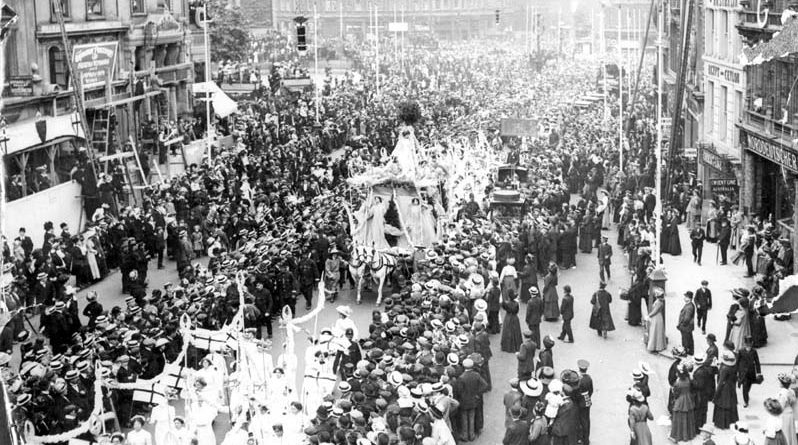Women making history at royal coronations
By Michelle Monaghan
ON MAY 6 2023, more than 18 million people across the UK watched the coronation of King Charles III and Queen Consort Camilla. It was a first for women who held some of the most critical roles in the sacred ceremony. Portsmouth MP Penny Mordaunt was the first woman ever to carry and present the Sword of State and the Jewelled Sword of Offering, the latter symbolising royal power and official acceptance by the King of his duty knightly virtues.
Female clergy members took an active part, three black women participated in various positions and 14 young female choristers sang alongside their male counterparts for the first time in history. However, it is not the first time women have made history at a coronation.
In 1911, an extraordinary event took place on a sunny afternoon in London. Women from 48 different suffragette societies marched through the streets from Westminster to Albert Hall. The women came from across the (then) British Empire representing England, New Zealand, Australia, Canada, South Africa, Inda, and the West Indies.
More than forty-thousand of them were marching a week before the coronation of King George V, the current monarch’s great-grandfather. It was organised by the Women’s Social and Political Union (WSPU) and they called the march the Women’s Coronation Procession.
The procession intended to gain the King’s support for the proposed Conciliation Bill. The bill was pending debate in Parliament and was created to extend voting rights to women. It had been read to Parliament a year earlier, in 1910.
It was also an opportunity to demonstrate women’s contribution to their country; many women were dressed as famous figures such as Joan of Arc, Anne Boleyn, Grace Darling, Mrs Somerville and more. Dressing as these women also brought attention to the current exclusion of women from crucial areas. Historically, the famous women they had dressed up as played a considerable part.
Because it was a week before the coronation, many people worldwide had been arriving in London for the ceremony. Combined with the general public, the women’s procession was viewed by flocks of people who packed the streets to watch the spectacle, which mirrored a royal coronation procession.
Like the Gold State Coach, the centrepiece of the procession was the ‘Car of the Empire’, a float meant to represent a united British Empire. The Museum of London described the float: “The top of the car were two figures representing East and West, and on the lowest tier were women depicting ‘the King’s dominions overseas’. Suffragettes from Croydon accompanied the float, which was preceded and followed by young women’ carrying garlands of roses, the emblem of England.”
Despite the enormous scale of the Women’s Coronation Procession and the number of people who went to watch it pass through London, the procession did not have the desired outcome. King George V would not support the Conciliation Bill, eventually rejected in the House of Commons. It would continue to drift in and out of Parliament through the years without success.
For the suffragette societies, it was a huge blow. It convinced the WSPU to continue its militant action to get its point across in the fight for women’s rights. In comparison, the women involved in King Charles III’s coronation did not have to make such big displays. But the Women’s Coronation Process was an important stepping stone in changing attitudes and leading the way for real action to support women’s rights.
So as we celebrate a new King and Queen, we should take the time to celebrate the impact of the Women’s Coronation Procession and how it reflects on the women who got to participate in this coronation.
You can visit the Museum of London’s photographic collection to see visual images of the Women’s Coronation Procession.
PICTURED BY MUSEUM OF LONDON: THE ‘CAR OF EMPIRE’, WOMEN’S CORONATION PROCESSION, 17 JUNE, 1911.



